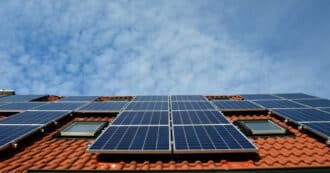By Ethel Mendius – Solar tubes are a cost effective way to brighten a room without using electricity. Using natural light in your home can help reduce your carbon footprint while enhancing your quality of life.
How Do Solar Tubes Work?
Solar tubes, otherwise known as sun tunnels or light tubes, are used to channel sunlight into a house’s interior: “natural light is collected on the roof by a polycarbonate or acrylic dome top, and a series of mirrors then reflect it down to the bottom of a sheet metal tube.”
The bottom of this tube feeds into a circular diffuser installed in the ceiling of a room, which looks like an ordinary light fixture. Throughout the day, these fixtures bring natural light into your home.
Output
Solar tubes are powerful for their small size. Each tube typically has a 10 or 14 inch diameter and provides as much light as three 100-watt bulbs, diffused evenly throughout the r0om.
Each solar tube light greatly reduces the need for artificial lighting. Just one is “enough to illuminate a 200 sq. ft. room well enough for office work or light a 300 sq. ft. room enough for less visual activities such as taking a shower or folding the laundry.”
Solar Tubes On Cloudy Days
Solar tubes are designed with a continuous mirror that “transfer[s] the maximum amount of daylight from the rooftop down into the interior with minimal light loss, even on cloudy days.” Because of this technology, they are a viable option even in cloudy settings.
That being said, “there will be a noticeable difference in light intensity between a clear, sunny day and a heavily overcast day.” This is a factor to consider before making your decision.
Electric Light Options
There are options for those who want their solar tube lighting to work throughout the night and in all weather conditions. While solar tubes are designed to run on natural light alone, “some newer products have integrated photovoltaic technologies [solar panels] to provide artificial lighting when the sun isn’t shining”.
The Benefits Of Solar Tubes
So, what are the main benefits of solar tubes? Let’s find out.
Low Maintenance
Solar tubes are designed with a weather resistant acrylic dome that prevents leaks and “also serves to keep it safe from insects, humidity, and sun damage.” If you install solar tubes, you will benefit from the natural light they offer with minimal upkeep.
When installed correctly, these tubes will provide decades of free lighting. The average solar tube has a lifespan of 10-20 years, and “higher-end models are said to last as long as 55.”
Energy efficiency
Solar tubes contribute to an energy efficient home by reducing the need for electric lighting, saving money on your energy bills. In every room a tube is installed, so that “you’ll no longer have to use an electric light on sunny or even moderately cloudy days.”
Energy efficiency benefits individuals and the planet at large. For example, in the UK, 21% of the carbon emissions driving climate change come from the home. Solar tubes, which reduce both carbon emissions and energy bills, are a choice consumers can feel good about.
Solar Tubes Versus Skylights
Solar tubes and skylights both can brighten dark spaces with natural light. Skylights are the more popular option, providing an attractive view and direct natural sunlight, but solar tubes offer their own advantages.
Design
Solar tubes may appeal to homeowners seeking the environmental or economic benefits of more natural light without a drastic change to their home design: “If you want to bring more light into your living room or bedroom without altering the room’s architecture, solar tubes let you do it.”
Because of their modest size, solar tubes offer a wide range of applications in the home. They work well in smaller spaces where there is no room for a skylight, offering “a practical way to brighten up a small, dim hallway or pantry.”
Cost
Skylights are not always the best option for budget-conscious consumers. Solar tubes could be the right choice “if you’re looking for an inexpensive way to introduce natural light to a space in your home and don’t need the full view of the sky that a skylight provides.”
For one, it costs less to install solar tubes, averaging $500-100 when done professionally. In comparison, skylights requires substantial carpentry work that can reach up to $2,000.
When it comes to energy efficiency, skylights may be counterintuitive. On hotter days, the direct sunlight offered by skylights can raise air conditioning costs.
How Are Solar Tube Lights Installed?
The price of solar tube installation reflects a straightforward process, “with setup, flashing, and finishing taking only a couple of hours or half a day’s work.” For those with building expertise, do-it-yourself solar tube kits are available at a cost of about $300.
The best choice depends on your level of knowledge as well as the structure of your roof: “in certain more complicated cases where installation requires fitting the tube around wiring, pipes or air ducts, you’ll get better results by hiring a professional.”
Choosing A Brand
Whether you hire contractors or do it yourself, it is wise to do your research and buy from an established company to meet your specific needs. There are many online resources to guide you in your choice.
Solatube, an Australian brand, has been on the market since the 1980s. Their line offers “several unique attachments to their solar tubes, giving customers plenty of options when it comes to customizing the appearance of their lighting”.
Solatube is a good choice for those seeking light in an overcast climate, because their patented technology “leads the pack in terms of light reflectivity, with the highest reflectivity percentage for its solar light tubes, at a level of 99.7%”.
An alternative is Velux, known as “the original Sun Tunnel manufacturer”. Velux offers a flexible tubing range that can ease installation, depending on your home’s architecture.
Velux’s line of sun tunnels include flex tunnels, which “can be used when the distance between the roof and the ceiling is too small for a rigid tunnel”, as well as rigid tunnels “for when the ceiling is placed directly under the exterior window”.
Would Solar Tubes Work In My Home?
Not every roof is suited for solar tube lighting. Most solar tubes are designed for roofs with a slope of 15° to 60°.
Flat roofs require special models and careful installation. In some cases, “on a steeply pitched roof, such as an A-frame, installation might not be possible at all.”
In humid environments, “condensation on the inside of the tube is a common problem.” However, there are ways to insulate your tube and prevent this issue ahead of time.
It also depends on your roofing material: “Most solar tube kits are designed for asphalt shingle roofing material, though adapters are readily available which make installation on wood, metal, or tile roof types straightforward.”
It is advisable to check for additional requirements by brand before proceeding with installation. For example, Velux requires “6 meters or less between your ceiling and your roof.”
The Environmental Benefits Of Solar Tubes
The effects of carbon emissions on our environment are well documented. The Paris agreement stresses the necessity of net zero, “a state in which the greenhouse gases going into the atmosphere are balanced by removal out of the atmosphere.”
Achieving net zero requires the cooperation of people, communities, and societies. While these changes can feel daunting, it is empowering to model positive change in our individual choices.
Solar tubes are on example of a small lifestyle change that can add up to make a great deal of difference. Ed Essex, a sustainability advocate living in Washington state, writes that solar tubes have reduced his daily light usage by an estimated 90% and are “a must have for any home.”
You do not need to be an avid environmentalist for your choices to be significant. Climate change affects everyone, and sustainable choices will bring benefits for ourselves while protecting the planet for future generations.
Solar Tubes And Religion
In Eco Bible, Rabbis Yonatan Neril and Leo Dee discuss a light source that sounds a lot like a solar tube. They discuss how in Noah’s ark there was a Tzohar, which according to the medieval biblical commentator, Rashi, was either an “opening” or a “stone that emits light.” Perhaps it was both.
The solar tube could roughly fit that description by being both an “opening” to outside, but also a stone (or more likely, metal) structure that emits far more light than a simple window. Perhaps Noah built a solar tube in the ark to fill the ark without light, without having to build large glass windows.
As a concluding thought, we can recognize a spiritual message in the solar tube as well. The solar tube takes in light and magnifies it. We can do the same in our work on behalf of Creation.
Sharing the inspiration we receive from our religious texts and environmentalism, we act like solar tubes and magnify that inspiration for others. We can bring more light to God’s Creation: all it takes is a little reflection!
* Featured image source







